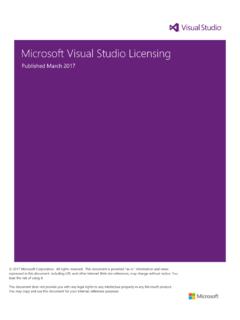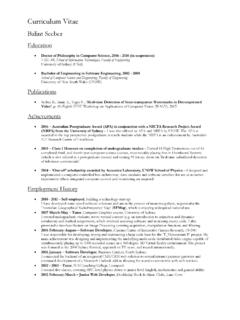Transcription of Top 10 Questions to Ask an Instructional Designer (Jul 06)
1 Top 10 Questions to Ask an Instructional Designer (Jul 06) July 6, 2006 Barry Krusch OK, now that you ve got the short list of candidates you want to interview. What Questions should you use? The same old generic ones applicable to any job or Questions specific to Instructional designers that should get you a lot of key differentiating information? If I was staffing a project, I would use the following Instructional - Designer -related Questions , because, very quickly, I would know who was who and who knew what. 1. What software do you use in your home office that makes you a more efficient/effective Instructional Designer ? The keys to this question are the phrases home office and more efficient/effective. You want to find the really professional Instructional designers.
2 The more professional they are, the more likely they are to have the right tools available to them in their own homes because good Instructional designers under deadlines will often take work home. These tools are right because they make the Designer far more efficient and effective than they would otherwise be. The best Instructional designers will use at least half of the applications on the following list: Microsoft Word s Outliner: If candidates say they are familiar with Microsoft Word s outliner, set them up for an interview on the spot! This tool, built into every copy of Microsoft Word, is essential for implementing concise and logically sound outlines. Because the course outline is the foundation for every course, you can see how important an outlining tool is.
3 Yet, you would be amazed at how few designers avail themselves of this most essential of tools. If the Designer has expressly indicated that they do use the outliner, ask if they could send along the course outline that they are most proud of, and spend five minutes with that outline to see how logically it is constructed. It will tell you a lot. If they do not indicate that they use this tool, ask them if they ever have used a similar tool. If they have not, pay much more attention to the other candidates. Everyday experience using an outliner is really that important. Speech-Recognition Software (Dragon NaturallySpeaking/IBM ViaVoice): With the amount of writing that they do, an Instructional Designer can boost his or her productivity 30 percent by dictating instead of typing.
4 If candidates use this software, it tells you two things: they are more productive, and more importantly, they know how to make themselves productive. It s this second quality that tells you about their ability to deliver ROI. Adobe Premiere: If they ve used this, they ve edited video, and what Designer hasn t had a need to these days? Sound Forge: An essential sound editing tool (voiceover work/CBT/WBT). Vegas Audio: Useful for creating audio tracks with sound composites (CBT/WBT). Macromedia Director: The most powerful tool for developing CBT/WBT. Macromedia Authorware: A common rapid application development environment for producing CBT/WBT. Macromedia Flash: The most common tool used to develop CBT/WBT. Microsoft Excel: All kinds of purposes in the areas of contact and project management.
5 Adobe Acrobat: This PDF creation tool is essential. Dreamweaver: Best HTML editor and site-management tool. Adobe Photoshop: Necessary for any kind of Web development. Microsoft Visual Studio: This latest development tool from Microsoft develops database-driven solutions within the Microsoft environment. Microsoft SQL Server: Professional designers who work with Microsoft databases will work with this not Microsoft Access. Camtasia: Fast screen recording tool makes quick Web-based training deliverables. Visio: Flowcharting tool useful in many contexts. Custom-Designed Macros Designers with a programming background will have custom designed their own macros in Microsoft Word useful for formatting paragraphs, automatic global search and replacing certain terms, etc.
6 One piece of software you might hear designers say they use is Microsoft Project. In my experience, this tool has not been very helpful because the parameters of projects are constantly changing, and I ve seen designers spend as much time editing their project plan in Microsoft Project as they do doing useful work on the project. I ve used custom-designed project management software to better effect. The other piece of software you probably will hear described most often besides Microsoft Word is PowerPoint, but its use is diminishing as more powerful tools are being developed. 2. What hardware do you use in your home office that makes you a more efficient/effective Instructional Designer ? FTP Server: Designers work with huge multimedia files, which are impossible to e-mail.
7 Consequently, experienced designers have a home connection to a separate computer offsite (called a server), allowing them to upload their files (downloadable later by clients). Telephone Headset: Designers are constantly on the phone with SMEs and other key contacts and need to take notes while they re talking. But as useful as this device is, you would be surprised at how few designers use it everyday. DSP Headset: This type of noise canceling headset is essential for quality voice recognition. Scanner (with Automatic Document Feeder): Designers are constantly scanning in documents for optical character recognition. Fax: A good legacy device for transferring hardcopy, being phased out by the scanner. Color Printer: For charts. Fast Desktop Computer: If you re working in video or photo manipulation as most designers do eventually, you need one of these.
8 Broadband Connection: Essential for fast transfer of Web files and videoconferencing. Backup Computers: When the computer goes down, does the project get put on hold? No, no, no! Router: Those with more than one computer and a broadband connection will have one of these. Laptop: No explanation necessary! CD Burner: For demos. Trackball: Excellent efficiency tool to conserve desktop space. Ergonomic Chair: If they don t have one, maybe they are not sitting in their chair 10 to 12-plus hours a day, in which case one of these feels so good! Video Camera: For video work. Studio Quality Microphone: For professional audio work. If they say they have one, ask which model (for example, AKG, Shure, Sennheiser, and so on). These first two Questions about software and hardware are great.
9 You would have an excellent chance of finding the Designer you are looking for just from these two Questions . But if you re looking for even more information, and you should be, continue! 3. Have you ever been in a situation where a manager or a client advocated an approach or standard you believed would be detrimental to the project? If so, how did you handle it? This is a great question to determine not only people skills, but also how the Designer will work as a team player. If that person interviewed has more than three years experience, the answer to the first part of this question should always be yes. And the answer to the second part should never be I just went along, because sanctioning a policy that hurts the team can never be helpful to the team.
10 Instead, look for creative solutions the candidate used that served the interests of the project without alienating the client. 4. What Instructional design and development methodology strategies have you used to deliver ROI to a client? This question and the next take us to the heart of the issue. Here the Designer should be able to detail exactly how he or she achieved their results. (For a sample of a possible answer to this question , see the ones I listed in the companion article). 5. Could you provide three examples of projects to which you added value beyond another Instructional Designer , and explain how you added that value? This question is related to the proceeding question and focuses on which projects. Get some good details with these two Questions .


